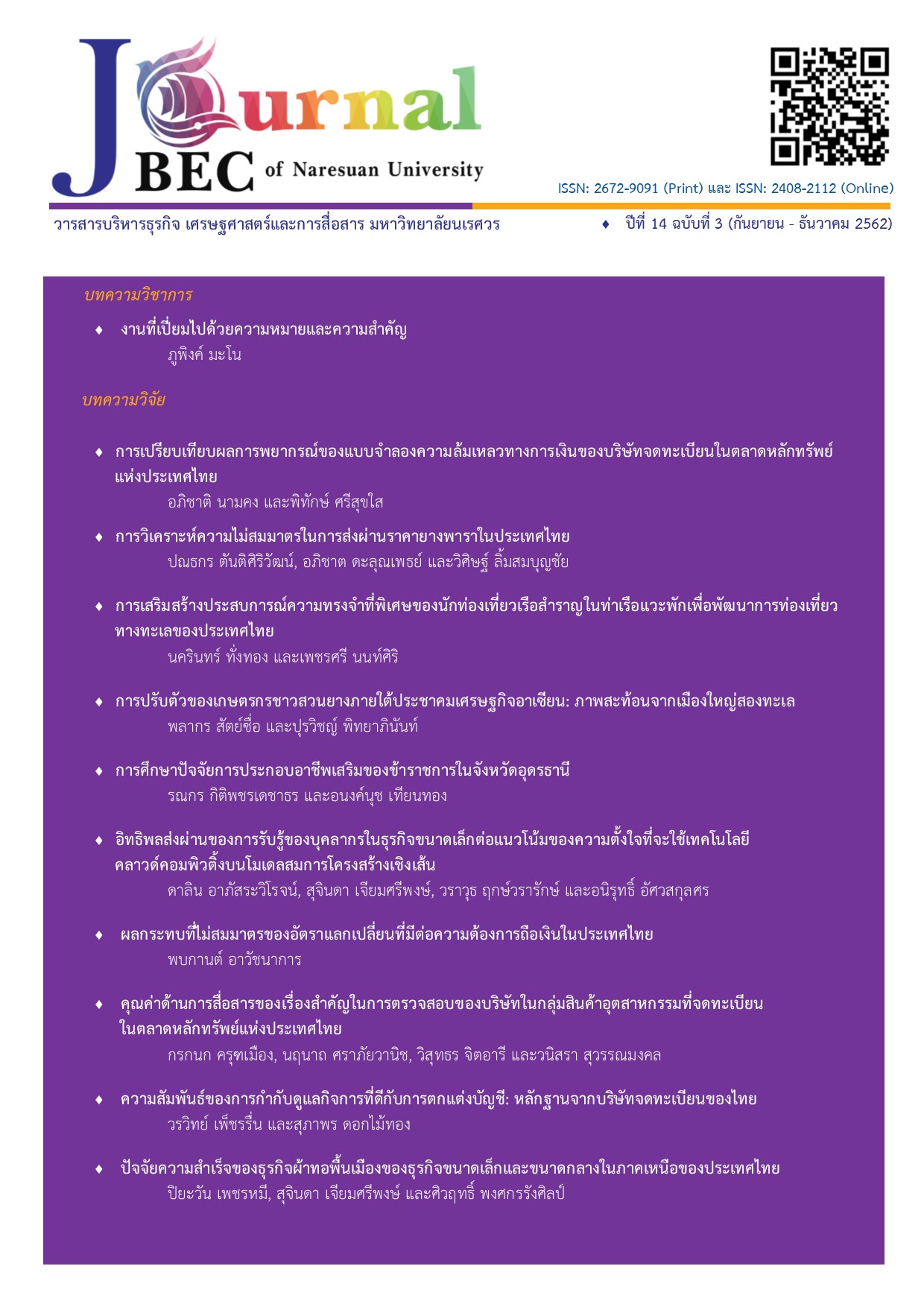ความสัมพันธ์ของการกำกับดูแลกิจการที่ดีกับการตกแต่งบัญชี: หลักฐานจากบริษัทจดทะเบียนของไทย
Main Article Content
บทคัดย่อ
บทคัดย่อ
งานวิจัยนี้มีวัตถุประสงค์เพื่อศึกษาความสัมพันธ์ของการกำกับดูแลกิจการที่ดีและการตกแต่งบัญชี
ของบริษัทในประเทศไทย กลุ่มตัวอย่างประกอบด้วยบริษัทจดทะเบียนในตลาดหลักทรัพย์แห่งประเทศไทย
และตลาด เอ็ม เอ ไอ และวัดการตกแต่งบัญชีด้วยจำนวนคงค้างที่เกินปกติของบริษัท การวิเคราะห์เชิงพหุพบว่า ในภาพรวมการกำกับดูแลกิจการที่ดีไม่มีความสัมพันธ์กับการตกแต่งบัญชีอย่างเป็นนัยสำคัญ อย่างไรก็ตาม
เมื่อแบ่งกลุ่มตัวอย่างที่มีจำนวนคงค้างที่เกินปกติเป็นค่าบวก (การตกแต่งบัญชีเพื่อเพิ่มตัวเลขกำไร) และค่าลบ (การตกแต่งบัญชีเพื่อลดตัวเลขกำไร) ผลการวิคราะห์พบว่า การกำกับดูแลกิจการที่ดีมีความสัมพันธ์เชิงลบ
กับจำนวนคงค้างที่เกินปกติค่าบวกอย่างเป็นนัยสำคัญแต่ไม่มีความสัมพันธ์อย่างเป็นนัยสำคัญต่อจำนวนคงค้าง
ที่เกินปกติค่าลบ ผลการศึกษาแสดงให้เห็นว่า การกำกับดูแลกิจการที่ดีอาจช่วยลดการตกแต่งบัญชีเพื่อเพิ่มตัวเลขกำไรได้
คำสำคัญ: 1) การกำกับดูแลกิจการที่ดี 2) การตกแต่งบัญชี 3) จำนวนค้างที่เกินปกติ
Article Details
เอกสารอ้างอิง
Becker, C. L., DeFond, M. L., Jiambalvo, J. and Subramanyam, K. R. (1998). The effect of audit quality on earnings management. Contemporary Accounting Research, 15(1), 1-24.
Bedard, J., Chtourou, S. M. and Courteau, L. (2004). The effect of audit committee expertise, independence and activity on aggressive earnings management. Auditing: A Journal of Practice and Theory, 23(2), 13-35.
Bradbury, M., Mak, Y. T. and Tan, S. M. (2006). Board characteristics, audit committee characteristics and abnormal accruals. Pacific Accounting Review, 18(2), 47-68.
Byard, D., Hossain, M. and Mitra, S. (2007). US oil companies’ earnings management in response to hurricanes Katrina and Rita. Journal of Accounting and Public Policy, 26(6), 733-748.
Cheng, C. S. A., Liu, Z. C. and Thomas, W. (2012). Abnormal accrual estimates and evidence of mispricing. Journal of Business Finance and Accounting, 39(1-2), 1-34.
CLSA. (2012). CG watch 2012: Tremors and Cracks. Retrieved January 23, 2019, from https://www.acga-asia.org/cgwatch-detail.php?id=152
CLSA. (2016). CG watch 2016: Ecosystems matter. Retrieved January 23, 2019, from www.acga-asia.org/upload/files/research_preview/20161014021202_3.pdf
Dechow, P. M. and Dichev, I. D. (2002). The quality of accruals and earnings: The role of accrual estimation errors. The Accounting Review, 77, 35-59.
Dechow, P. M., Sloan, R. G. and Sweeney, A. P. (1995). Detecting earnings management.
The Accounting Review, 70(2), 193-225.
Franz, D. R., HassabElnaby, H. R. and Lobo, G. J. (2014). Impact of proximity to debt covenant violation on earnings management. Review of Accounting Studies, 19(1), 473-505.
Healy, P. M. and Wahlen, J. M. (1999). A review of the earnings management literature and its implications for standard setting. Accounting Horizons, 13(4), 365-383.
Hsiao, D. F., Hu, Y. and Lin, J. W. (2016). The earnings management opportunity for US oil and gas firms during the 2011 Arab Spring event. Pacific Accounting Review, 28(1), 71-91.
Hutchinson, M. R., Percy, M. and Erkurtoglu, L. (2008). An investigation of the association between corporate governance, earnings management and the effect of governance reforms. Accounting Research Journal, 21(3), 239-262.
Jaggi, B. and Leung, S. (2007). Impact of family dominance on monitoring of earnings management by audit committees: Evidence from Hong Kong. Journal of International Accounting, Auditing and Taxation, 16(1), 27-50.
Jaggi, B., Leung, S. and Gul, F. (2009). Family control, board independence and earnings management: Evidence based on Hong Kong firms. Journal of Accounting and Public Policy, 28(4), 281-300.
Jones, J. J. (1991). Earnings management during import relief investigations. Journal of Accounting Research, 29(2), 193-228.
Kothari, S. P., Leone, A. J. and Wasley, C. E. (2005). Performance matched discretionary accrual measures. Journal of Accounting and Economics, 39(1), 163-197.
Lhaopadchan, S., Budsaratragoon, P. and Hillier, D. (2016). Earnings management, corporate governance and insider trading: Evidence from Thailand. Chulalongkorn Business Review, 38(149), 107-156.
Mansor, N., Che-Ahmad, A., Ahmad-Zaluki, N. A. and Osman, A. H. (2013). Corporate governance and earnings management: A study on the Malaysian family and non-family owned PLCs. Procedia Economics and Finance, 7, 221-229.
Phetruen, W. (2018). Earnings management behaviour and related factors. Journal of Business, Economics and Communications, 13(1), 29-40.
Saleh, N. M. and Ahmed, K. (2005). Earnings management of distressed firms during debt renegotiation. Accounting and Business Research, 35(1), 69-86.
Securities and Exchange Commission, Thailand (SEC). (n.d.). Corporate governance code for listed companies 2017. Retrieved April 26, 2019 from https://www.sec.or.th/
cgthailand/TH/Pages/CGCode/CGCodeIntroduction.aspx
Sharma, V. D. and Kuang, C. (2014). Voluntary audit committee characteristics, incentives, and aggressive earnings management: Evidence from New Zealand. International Journal of Auditing, 18(1), 76-89.
Shen, C. H. and Chih, H. L. (2007). Earnings management and corporate governance in Asia’s emerging markets. Corporate Governance: An International Review, 15(5), 999-1021.
Stock Exchange of Thailand (SET). (n.d.). The principles of good corporate governance for listed companies 2012. Retrieved November 16, 2017 from https://www.set.or.th/
sustainable_dev/th/cg/files/2013/CGPrinciple2012Thai-Eng.pdf
Tengamnuay, K. and Stapleton, P. (2009). The role of the audit committee in Thailand: a mature monitoring mechanism or an evolving process?. Journal of Management and Governance, 13(3), 131-161.
Thai Institute of Directors Association (IOD). (2013). Corporate governance report of Thai listed companies 2013. Retrieved July 23, 2015, from www.thai-iod.com/imgUpload/CGR Report 2013.pdf
Thai Institute of Directors Association (IOD). (2014). Corporate governance report of Thai listed companies 2014. Retrieved July 23, 2015, from www.thai-iod.com/imgUpload/CGR 2014 Report(3).pdf
Thai Institute of Directors Association (IOD). (2015). Corporate governance report of Thai listed companies 2015. Retrieved October 21, 2018, from www.thai-iod.com/imgUpload/
CGR2015 Report.pdf
Thai Institute of Directors Association (IOD). (2016). Corporate governance report of Thai listed companies 2016. Retrieved October 21, 2018, from www.thai-iod.com/imgUpload/CGR 2016 Report(1).pdf
Thai Institute of Directors Association (IOD). (2017). Corporate governance report of Thai listed companies 2017. Retrieved October 21, 2018, from www.thai-iod.com/imgUpload/CGR Report 2017.pdf
Thoopsamut, W. and Jaikengkit, A. (2009). Audit committee characteristics, audit firm size and quarterly earnings management in Thailand. Oxford Journal, 8(1), 3-12.
White, S. (2004). Stakeholders, structure and the failure of corporate governance reform initiatives in post-crisis Thailand. Asia Pacific Journal of Management, 21(1-2), 103-122.


